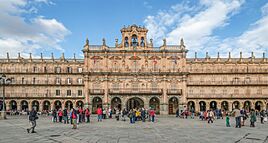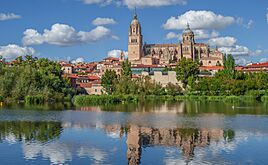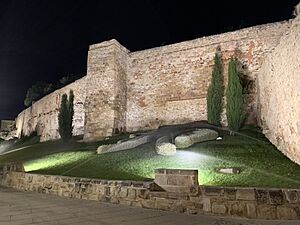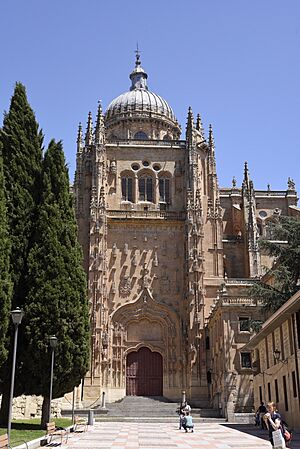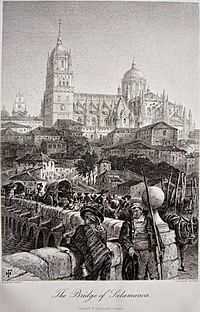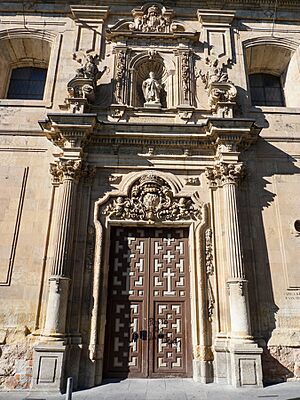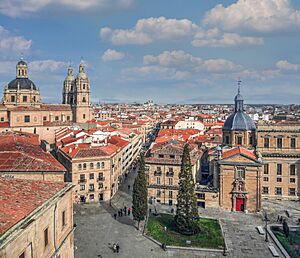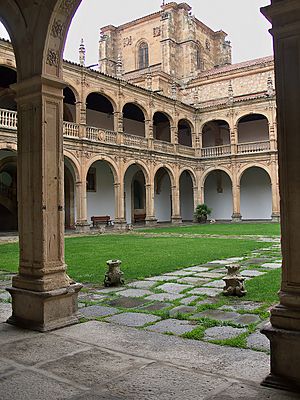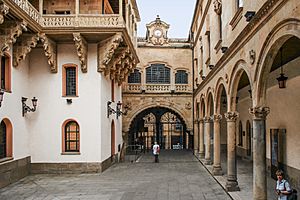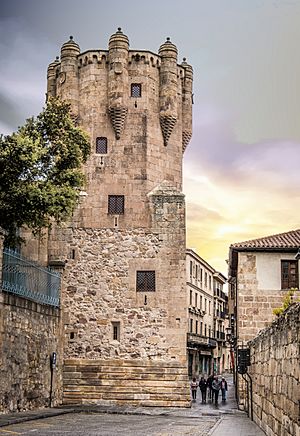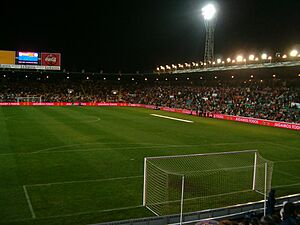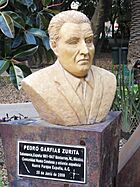Salamanca facts for kids
Quick facts for kids
Salamanca
|
|||||||||||||||||||
|---|---|---|---|---|---|---|---|---|---|---|---|---|---|---|---|---|---|---|---|
|
Rúa Mayor
|
|||||||||||||||||||
|
|||||||||||||||||||
| Country | Spain | ||||||||||||||||||
| Autonomous community | Castile and León | ||||||||||||||||||
| Province | Salamanca | ||||||||||||||||||
| Area | |||||||||||||||||||
| • Total | 38.6 km2 (14.9 sq mi) | ||||||||||||||||||
| Elevation | 802 m (2,631 ft) | ||||||||||||||||||
| Population
(2020)
|
|||||||||||||||||||
| • Total | 144,825 | ||||||||||||||||||
| • Density | 3,752/km2 (9,717/sq mi) | ||||||||||||||||||
| Time zone | UTC+1 (CET) | ||||||||||||||||||
| • Summer (DST) | UTC+2 (CEST) | ||||||||||||||||||
| Area code(s) | 34 (Spain) + 923 (Salamanca) | ||||||||||||||||||
|
|||||||||||||||||||
Salamanca is a beautiful city in Spain. It is the capital of the province with the same name. You can find it in the Castile and León region. The city is famous for its many amazing buildings in the Plateresque style.
Salamanca is very old, about 2700 years old! The first people settled here on the San Vicente hill. Many different groups have lived here over time. These include the Vaccaei, Vettones, Romans, Visigoths, and Muslims. Later, Raymond of Burgundy helped rebuild the city in the Middle Ages.
The city is home to the University of Salamanca. It is the oldest active university in Spain. It was started in 1218. This university was once one of the most important in the Western world. Many famous people have connections to Salamanca. These include Christopher Columbus and Miguel de Unamuno.
In 1988, the Old City of Salamanca became a World Heritage Site by UNESCO. This means it is a very special place. It has many historic buildings. Some of the most famous are its two cathedrals, the Casa de las Conchas, and the Plaza Mayor. Since 2003, Holy Week in Salamanca has been a major tourist event.
Salamanca also has important science and research centers. It is a world leader in teaching Spanish language. Many students from other countries come here to learn Spanish.
Contents
What's in a Name?
The name Salamanca has a few possible origins. Some ancient Greeks called it Helmantike. This name might have meant "Land of divination." Others called it Salmantica.
One theory says the city was founded by Teucer. He was a hero from the Trojan War. He named the city Salamatica, after his home, Salamis. Another idea is that the name comes from an old god called Helman.
City Symbols
The City's Coat of Arms
Salamanca has an official coat of arms. It was approved in 1996. It shows a stone bridge with a bull crossing it. Behind the bull is a fig tree. The shield also has four red poles on a gold background. Around the edge are eight silver crosses. Above the shield is a royal crown.
The City's Flag
The city flag is red. In the center, it has the coat of arms of Salamanca. The flag is rectangular, with a length that is 1.5 times its height.
Salamanca's History
Salamanca has played a big part in world history. Many important events and people are linked to the city.
Salamanca's Impact on History
- First Spanish Grammar: In 1492, Antonio de Nebrija wrote the first grammar book for the Spanish language. This was a huge step for the language.
- Columbus's Journey: Christopher Columbus discussed his plans for his first voyage here. He got support from the Dominicans.
- Conquerors' Studies: Hernán Cortés, who conquered the Aztec Empire, studied in Salamanca.
- Human Rights Ideas: The School of Salamanca defended the rights of native peoples in the New World. They helped create modern ideas about human rights and international law.
- The Gregorian Calendar: Scientists from the University of Salamanca helped create the Gregorian calendar. This is the calendar we use today.
- Bible Translation: Friar Luis de León translated parts of the Bible into Spanish.
- Chess Book: The oldest printed book about modern chess was published in Salamanca in 1496.
- Cervantes's Inspiration: The famous writer Miguel de Cervantes lived in Salamanca. He mentioned the city in his famous book, Don Quixote of la Mancha.
Ancient Times

People first lived in the Salamanca area around 1000 BC. The earliest permanent settlement was on the San Vicente hill. Later, another town grew on the "teso de las catedrales." These spots were chosen because they were easy to defend. They were also close to the Tormes River.
Around 220 BC, Hannibal attacked and conquered the ancient city. The people of Helmantica, as it was called, fought bravely. Their women even hid weapons to help. Hannibal was so impressed that he returned their homes and wealth.
After the Second Punic War, the Romans took over. Salamanca became a Roman city. They built important structures.

- The Silver Road: This was a main road that helped the city grow.
- The Roman Bridge: Built in the 1st century, this bridge still stands today. It allowed people to cross the Tormes River.
- The Old Wall: The Romans also built a wall around the city.
Recently, a marble statue from the Roman period was found. This shows how important Salamanca was back then.
The Middle Ages
After the Roman Empire, the Visigoths took control. Not much is known about Salamanca during this time. The Roman walls were made stronger. In 712, Musa ibn Nusayr and the Muslims conquered the city.
For a long time, the area was a "no man's land." Many towns were destroyed by frequent attacks. Salamanca became a small, almost empty place.
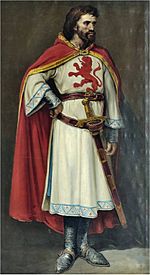
In the 10th century, Ramiro II of León began to repopulate the area. People from northern Spain moved here.
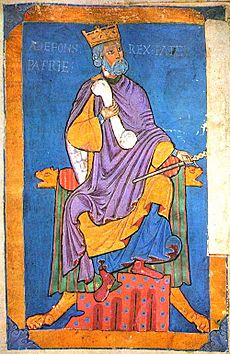
.
In 1085, King Alfonso VI of León ordered the city to be fully repopulated. Raymond of Burgundy brought many new settlers. These included people from different parts of Spain and even Jews and Muslims. They built their own churches and neighborhoods.
The city's diocese was restarted. The Old Cathedral began to be built. Schools were also founded next to it. These schools would later become the famous university.

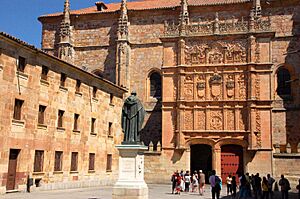
In 1218, King Alfonso IX of León gave special rights to the city. This helped it grow and attract more people. The cathedral schools became a studium generale. In 1254, King Alfonso X of Castile officially made it the University of Salamanca. This was confirmed by Pope Alexander IV in 1255. The university quickly became very respected.
In the 15th century, Salamanca faced conflicts. Two noble families, the Benitinos and Tomesinos, fought for control. This was known as the "War of the Bandos." A brave friar, Saint John of Sahagún, helped bring peace.
By the early 1500s, most people lived on the north side of the Tormes River. Salamanca also became important for making cloth and exporting wool.
Early Modern Times
In 1520, Salamanca joined the Revolt of the Comuneros. This was a movement against new taxes. After the revolt failed, King Charles V ordered the tops of some palaces to be removed.
The 16th century was Salamanca's golden age. The city grew, and the university became very famous. This was thanks to the School of Salamanca. This group of scholars made important contributions to law and economics. They also spoke out against the mistreatment of native peoples in the Americas.
In 1551, the Holy Roman Emperor Charles V asked if the work of a doctor named Andreas Vesalius was okay with Catholic teachings. Vesalius came to Salamanca and was found innocent.
The Jewish quarter was walled up after Jews were expelled in 1492. It became known as "barrio del Conejal" (Rabbit neighborhood).

In the 18th century, Salamanca saw a new boom. The New Cathedral of Salamanca was finished. The grand Baroque Plaza Mayor was built in 1729. When the huge Lisbon earthquake of 1755 hit, many buildings were damaged. But the city's wealth helped repair them.
Modern Times
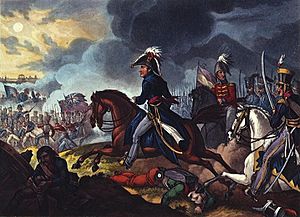
During the Peninsular War, French troops occupied Salamanca in 1809. They destroyed many buildings for materials. In 1812, Wellington's army defeated the French in the Battle of Arapiles. This battle caused much damage to the city. Later, the University of Salamanca became a smaller, provincial university.
In 1833, the province of Salamanca was created. Salamanca became its capital.
The city slowly recovered in the 19th century. A railroad connecting France and Portugal was built through Salamanca in 1877.
During the Spanish Civil War (1936–1939), Salamanca supported the Nationalist side. It was used as a temporary headquarters for their leader, Francisco Franco. After the war, many documents from the Republican side were stored in Salamanca. Some of these documents were later moved to Barcelona.
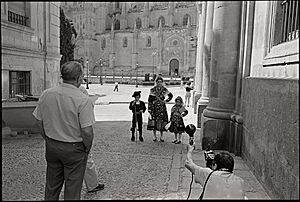
In 1940, the Pontifical University of Salamanca was founded. In 1988, Salamanca was named a World Heritage City by UNESCO. In 2002, it was a European Capital of Culture.
Today, Salamanca's population is around 160,000. Many people have moved to the surrounding areas. The city's economy relies on its university and tourism. It is a popular place for students to learn Spanish. In 1994, Salamanca hosted a big conference on special needs education. In 2005, it hosted the XV Ibero-American Summit.
City Geography
Salamanca is located in the Campo Charro area. It is about 64 kilometers from Zamora and 123 kilometers from Portugal.
The city sits where two different land types meet. To the north and east are flat plains used for farming. To the south and west are oak forests and pastures. This area is known as Campo Charro. The city is about 800 meters above sea level.
Climate in Salamanca
Salamanca has a cold semi-arid climate. This means it has dry, hot summers and cool winters.
| Climate data for Salamanca Airport 790 m (2,590 ft) 1991–2020 normals, 1945-present extremes | |||||||||||||
|---|---|---|---|---|---|---|---|---|---|---|---|---|---|
| Month | Jan | Feb | Mar | Apr | May | Jun | Jul | Aug | Sep | Oct | Nov | Dec | Year |
| Record high °C (°F) | 21.7 (71.1) |
25.0 (77.0) |
26.1 (79.0) |
31.0 (87.8) |
34.5 (94.1) |
39.4 (102.9) |
40.9 (105.6) |
41.1 (106.0) |
39.0 (102.2) |
34.8 (94.6) |
24.8 (76.6) |
20.2 (68.4) |
41.0 (105.8) |
| Mean maximum °C (°F) | 12.0 (53.6) |
15.6 (60.1) |
20.4 (68.7) |
22.7 (72.9) |
26.1 (79.0) |
30.9 (87.6) |
35.2 (95.4) |
33.3 (91.9) |
29.9 (85.8) |
24.7 (76.5) |
16.9 (62.4) |
13.7 (56.7) |
35.2 (95.4) |
| Mean daily maximum °C (°F) | 9.1 (48.4) |
11.6 (52.9) |
15.2 (59.4) |
17.3 (63.1) |
21.8 (71.2) |
27.3 (81.1) |
30.6 (87.1) |
30.2 (86.4) |
25.5 (77.9) |
19.6 (67.3) |
13.0 (55.4) |
9.9 (49.8) |
19.3 (66.7) |
| Daily mean °C (°F) | 4.3 (39.7) |
5.5 (41.9) |
8.4 (47.1) |
10.7 (51.3) |
14.7 (58.5) |
19.1 (66.4) |
21.6 (70.9) |
21.3 (70.3) |
17.5 (63.5) |
12.9 (55.2) |
7.7 (45.9) |
5.0 (41.0) |
12.4 (54.3) |
| Mean daily minimum °C (°F) | −0.6 (30.9) |
−0.6 (30.9) |
1.6 (34.9) |
4.0 (39.2) |
7.6 (45.7) |
10.9 (51.6) |
12.5 (54.5) |
12.3 (54.1) |
9.4 (48.9) |
6.2 (43.2) |
2.4 (36.3) |
0.1 (32.2) |
5.5 (41.9) |
| Mean minimum °C (°F) | −4.6 (23.7) |
−5.5 (22.1) |
−1.5 (29.3) |
1.0 (33.8) |
4.4 (39.9) |
8.6 (47.5) |
10.2 (50.4) |
10.1 (50.2) |
7.0 (44.6) |
1.8 (35.2) |
−2.8 (27.0) |
−5.7 (21.7) |
−5.7 (21.7) |
| Record low °C (°F) | −15.6 (3.9) |
−20.0 (−4.0) |
−9.0 (15.8) |
−5.5 (22.1) |
−2.3 (27.9) |
2.0 (35.6) |
5.0 (41.0) |
4.5 (40.1) |
0.3 (32.5) |
−4.7 (23.5) |
−10.6 (12.9) |
−12.0 (10.4) |
−20.0 (−4.0) |
| Average precipitation mm (inches) | 31.7 (1.25) |
25.6 (1.01) |
27.7 (1.09) |
38.7 (1.52) |
39.0 (1.54) |
21.8 (0.86) |
8.1 (0.32) |
11.9 (0.47) |
29.3 (1.15) |
51.3 (2.02) |
39.4 (1.55) |
36.7 (1.44) |
361.2 (14.22) |
| Average precipitation days (≥ 1 mm) | 6.0 | 5.3 | 5.6 | 8.0 | 6.8 | 3.5 | 1.6 | 1.7 | 4.1 | 7.6 | 7.6 | 6.1 | 63.9 |
| Mean monthly sunshine hours | 122 | 168 | 215 | 238 | 286 | 329 | 371 | 344 | 268 | 198 | 133 | 116 | 2,788 |
| Source 1: Météo Climat | |||||||||||||
| Source 2: Infoclimat | |||||||||||||
| Climate data for Salamanca Airport 790 m (2,590 ft) 1981-2010 normals, 1945-present | |||||||||||||
|---|---|---|---|---|---|---|---|---|---|---|---|---|---|
| Month | Jan | Feb | Mar | Apr | May | Jun | Jul | Aug | Sep | Oct | Nov | Dec | Year |
| Record high °C (°F) | 21.7 (71.1) |
25.0 (77.0) |
26.1 (79.0) |
31.0 (87.8) |
34.5 (94.1) |
39.4 (102.9) |
40.9 (105.6) |
41.1 (106.0) |
39.0 (102.2) |
34.8 (94.6) |
24.8 (76.6) |
20.2 (68.4) |
41.1 (106.0) |
| Mean daily maximum °C (°F) | 8.6 (47.5) |
11.2 (52.2) |
14.9 (58.8) |
16.5 (61.7) |
20.6 (69.1) |
26.6 (79.9) |
30.0 (86.0) |
29.5 (85.1) |
25.1 (77.2) |
18.9 (66.0) |
12.8 (55.0) |
9.4 (48.9) |
18.7 (65.7) |
| Daily mean °C (°F) | 4.0 (39.2) |
5.5 (41.9) |
8.3 (46.9) |
10.1 (50.2) |
14.0 (57.2) |
18.8 (65.8) |
21.5 (70.7) |
21.1 (70.0) |
17.6 (63.7) |
12.6 (54.7) |
7.9 (46.2) |
4.9 (40.8) |
12.2 (54.0) |
| Mean daily minimum °C (°F) | −0.7 (30.7) |
−0.2 (31.6) |
1.7 (35.1) |
3.8 (38.8) |
7.3 (45.1) |
11.0 (51.8) |
12.9 (55.2) |
12.6 (54.7) |
10.0 (50.0) |
6.4 (43.5) |
2.4 (36.3) |
0.4 (32.7) |
5.6 (42.1) |
| Record low °C (°F) | −15.6 (3.9) |
−20.0 (−4.0) |
−9.0 (15.8) |
−5.5 (22.1) |
−2.3 (27.9) |
2.0 (35.6) |
5.0 (41.0) |
4.5 (40.1) |
0.3 (32.5) |
−4.7 (23.5) |
−10.6 (12.9) |
−12.0 (10.4) |
−20.0 (−4.0) |
| Average precipitation mm (inches) | 30 (1.2) |
25 (1.0) |
21 (0.8) |
38 (1.5) |
47 (1.9) |
29 (1.1) |
11 (0.4) |
12 (0.5) |
32 (1.3) |
46 (1.8) |
40 (1.6) |
42 (1.7) |
372 (14.6) |
| Average precipitation days | 5.8 | 5.4 | 4.7 | 7.4 | 7.9 | 3.8 | 1.8 | 1.9 | 4.2 | 7.1 | 6.9 | 6.9 | 63.8 |
| Average snowy days | 1.6 | 1.9 | 0.8 | 0.8 | 0.2 | 0 | 0 | 0 | 0 | 0 | 0.5 | 1.2 | 7 |
| Average relative humidity (%) | 82 | 73 | 63 | 62 | 59 | 52 | 47 | 51 | 59 | 71 | 79 | 83 | 65 |
| Mean monthly sunshine hours | 118 | 154 | 211 | 224 | 265 | 317 | 358 | 330 | 251 | 183 | 130 | 104 | 2,667 |
| Source: Agencia Estatal de Meteorología | |||||||||||||
Rivers and Water
The Tormes River flows through Salamanca. The Zurguén stream also runs through the area. The Tormes River has been very important for the city's history. A dam helps control the river and provides drinking water. It also helps prevent floods.
Amazing Buildings and Places
The old city of Salamanca is a World Heritage Site. This means it has many important and beautiful buildings.
Squares and Open Spaces
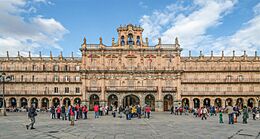
- The Plaza Mayor: This is the main square and the heart of the city. It is built in the Baroque style. The City hall of Salamanca is the most important building here.
- Campo de San Francisco: This was the city's first public garden.
- Huerto de Calixto y Melibea: A garden near the cathedrals. Some say a famous novel, La Celestina, takes place here. You can also see parts of the old Roman walls.
- Plaza del Corrillo: A small square next to the Plaza Mayor. It has the Romanesque church of San Martín.
Churches and Religious Sites
The Cathedrals
Salamanca has two cathedrals. The Old Cathedral is from the 12th century and is Romanesque in style. The New Cathedral is much larger. It was started in the 16th century in Gothic architecture style. It was finished in the 18th century. The spot where they meet is called Patio Chico. It's a very charming part of the city.
The main tower of the new cathedral was built over the old one. You can still see a crack from the Lisbon earthquake of 1755.
La Clerecía
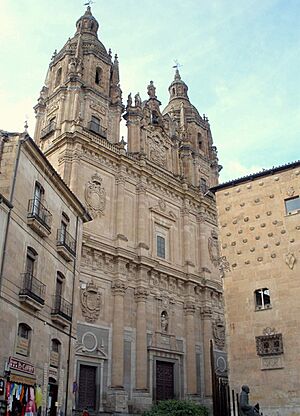
This building is now part of the Pontifical University of Salamanca. It was built between 1617 and 1754. It is a Baroque style building. It has an impressive front with two tall towers and a huge dome.
Convento de San Esteban
This is a Dominican convent from the 16th century. Its Plateresque front is a beautiful example of Renaissance art. It also has a stunning Baroque altar.
Convento de las Dueñas
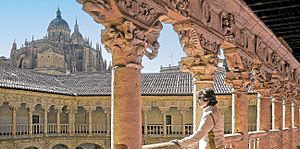
Built in 1533, this convent is known for its amazing cloister. The cloister has an unusual five-sided shape. It has two floors with unique columns and carvings.
Other Important Churches
- Chapel of la Vera Cruz: A Baroque church with a Renaissance front. It holds many artworks.
- Colegio de Calatrava: Built in the 18th century, it now houses the "House of the Church."
- Convento de las Agustinas e Iglesia de la Purísima: This church has a painting of the Immaculate Conception by José de Ribera. It is unique in Spain for its Italian style.
- Convento de las Isabeles: This convent has a beautiful Mudéjar style wooden ceiling.
- Convento de la Anunciación: Founded in 1512, it has a Gothic back part. Inside, you can see a Baroque altar.
- Church of San Benito: A Gothic church built in the 15th century.
- Church of San Marcos: A Romanesque church with a round shape.
- Church of San Martín: A Romanesque church with later changes. It is next to the Plaza Mayor.
- Church of San Pablo: A Baroque church that holds a very loved image of Jesus.
- Church of Santiago del Arrabal: A church in Romanesque-Mudéjar style.
- Church of Santo Tomás Cantuariense: A Romanesque church built in honor of Thomas Becket in 1175.
University Buildings
- University Buildings: These are the old buildings of the University of Salamanca. They include the Escuelas Mayores and Escuelas Menores. They are located around the Patio de Escuelas square.
- Casa-Museo de Unamuno: This was the house of the university's rectors. It is now a museum, kept as it was when Miguel de Unamuno lived there.
- Colegio Mayor de Santiago el Zebedeo: Also called "del Arzobispo Fonseca," built in the 16th century.
- Colegio de San Ambrosio: Built in 1719, it is now the General Archive of the Spanish Civil War. It holds documents from the Spanish Civil War.
- Colegio Trilingüe: Founded in 1554 to teach Latin, Greek, and Hebrew.
- Palacio de Anaya: This was the last home of the Colegio Mayor de San Bartolomé. It is now the Faculty of Philology.
- Colegio Santa Cruz de Cañizares: Built in the 16th century, it is now a music conservatory.
- Colegio de San Pelayo: Founded in the 16th century, it now houses the Faculty of Geography and History.
Palaces and Grand Houses

- Casa de las Conchas (House of Shells): Built in the late 15th century. Its front is covered with about 350 scallop shells. It is now a public library.
- Casa de Don Diego Maldonado: A Plateresque palace from the 16th century.
- Casa de doña María la Brava: A Gothic building from the 15th century. Its owner, María Rodríguez de Monroy, was a strong leader during the city's conflicts.
- Casa Lis: A small Art Nouveau palace from 1905. It is built on the city wall. It houses an Art Nouveau and Art Deco museum.
- Casa de las Muertes (House of Deaths): Built in the early 16th century. It is named for the skulls that decorate its front.
- Casa del Regidor Ovalle: Miguel de Unamuno died here.
- Casa de Saint Teresa of Ávila: The saint stayed here in 1570.
- Casa de los Sexmeros de la Tierra: A 15th-century house that is now the Chamber of Commerce.
- Casa de las Viejas: A 17th-century building that was once an asylum. It now holds the Film Archive.
- Palacio de San Boal: A 15th-century palace with unique decorations.
- Palacio de Castellanos: Started in the late 15th century. It is now a hotel.
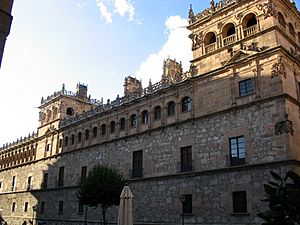
- Palacio de Garci Grande: A 16th-century Renaissance palace.
- Palacio de Monterrey: Built in the 16th century in Plateresque style. It belongs to the house of Alba.
- Palacio de Orellana: A 16th-century building with classicist and mannerist influences.
- Palacio de Rodríguez de Figueroa: Built in 1545, it is now the Casino of Salamanca.
- Palacio de la Salina: A Renaissance palace from 1546. It is the seat of the provincial government.
- Palacio de Arias Corvelle: A 15th-century palace with decorated walls. It is now a cultural center.
- Palacio de Solís: The wedding of Philip II of Spain and Maria Manuela of Portugal was held here in 1543.
- Torre del Aire: All that remains of a 15th-century palace. It is now a student residence.
- Torre del Clavero: Parts of a palace built around 1470. It has a square base and an octagonal top.
- Torre de los Anaya: An old manor house from the 15th century. It was once a university institute.
University Life

The University of Salamanca was founded in 1134. In 1218, King Alfonso IX of León gave it a royal charter. It was the first university to be called a "University" in 1254. Under King Alfonso X, its fame grew. Its law schools attracted students from all over Europe. In the 16th century, the university was very important to the city.
Salamanca's Economy

The city's economy mainly relies on the university and tourism. Other important areas include farming, raising animals, construction, and manufacturing. In 2007, most workers (83%) were in the service sector.
City Industries
About 5% of the working people are in industry. Two of the biggest companies are "Laboratorios Intervet," which makes animal vaccines, and S.A. Mirat, which makes fertilizer. Mirat is the city's oldest industrial company, started in 1812.
Getting Around Salamanca
Roads
Salamanca is connected by several major highways:
- A50: Autovía de la Cultura (connects to Ávila)
- A62: Autovía de Castilla (connects to Burgos and Valladolid)
- A66: Autovía Ruta de la Plata (a long route from Gijón to Sevilla)
Airport
Salamanca Airport is about 14 kilometers east of the city. It is located at a military base.
Public Transportation
The city has 13 bus lines during the day and two at night. There have also been talks about adding a tram line.
Culture and Fun
The Old City of Salamanca was named a UNESCO World Heritage Site in 1988. In 2002, Salamanca was a European Capital of Culture. In 2005, the city celebrated the 250th anniversary of its Plaza Mayor.
Festivals and Celebrations
Holy Week
Holy Week in Salamanca is the most famous festival in the city. It is known for its serious and respectful parades. Over 10,000 members of religious groups take part. They carry 50 floats showing scenes from the Passion of Christ. In 2003, Holy Week in Salamanca was recognized as an event of international tourist interest.
Other Events
Salamanca is also famous for "Nochevieja Universitaria." This is a "University New Year" celebration. It usually happens in December, two weeks before the actual New Year's Eve. Students gather in the Plaza Mayor for free shows and a countdown to midnight.
Sports in Salamanca
"Los Charros," also known as the Union Deportiva Salamanca, was the city's football team. It closed in 2013. Now, the Club de Fútbol Salmantino continues its legacy.
In 1993, Javier Sotomayor made the first high jump over 8 feet (2.44 m) in Salamanca. His jump of 2.45 m is still the world record.
Local Sports Teams
- Salamanca CF: A football (soccer) team.
- Unionistas de Salamanca CF: Another football team.
- CB Avenida: A basketball team.
- Club Natación Acuático Salamanca: A swimming team.
Salamanca in Movies
The city's beautiful setting has been used in several films. These include Ridley Scott's 1492: Conquest of Paradise and Miloš Forman's Goya's Ghosts. Alejandro Amenábar's 2019 film While at War is also set in Salamanca.
Delicious Food
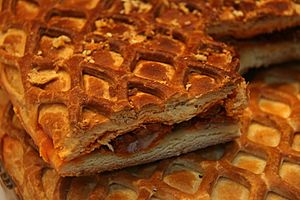
Salamanca has many local dishes. chanfaina (steamed rice with pork) is very popular. Another special dish is cocido, a slow-cooked chickpea stew. But the most popular dish is hornazo, a meat pie.
Partner Cities
Salamanca is twinned with these cities:
Famous People from Salamanca
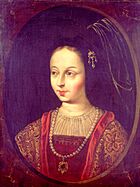
Public Service
- Alfonso XI of Castile (1311–1350): A King of Castile and León.
- Beatriz Galindo (ca.1465 – 1535): A Spanish writer, teacher, and scholar.
- Francisco Vázquez de Coronado (1510–1554): A conquistador who explored parts of Mexico and Kansas.
- Alfonso Fernández Mañueco (born 1965): A politician who was Mayor of Salamanca.
Arts and Culture
- Fernando Gallego (1440–1507): A Spanish painter.
- Diego de Torres Villarroel (1693–1770): A writer, poet, and professor at the University of Salamanca.
- Miguel de Unamuno (1864–1936): A famous writer, novelist, and philosopher.
- María del Rosario López Piñuelas (born 1943): A well-known actress.
- Yann Martel (born 1963): A Canadian author who wrote Life of Pi.
Science and Business
- Abraham Zacuto (1452 – ca.1515): A Jewish astronomer and mathematician.
- Mark Russinovich (born 1966): A software engineer and current Chief Technology Officer of Microsoft Azure.
- Susana Marcos Celestino (born 1970): A physicist who studies human vision.
Sports Stars

- Vicente del Bosque (born 1950): A famous football player and manager for Spain.
- Teodora Ruano (born 1969): A retired cyclist who competed in the Olympics.
- Álvaro Arbeloa (born 1983): A football player who played for Spain.
- David Alcaide (born 1978): A professional pool player.
See More
 In Spanish: Salamanca para niños
In Spanish: Salamanca para niños


